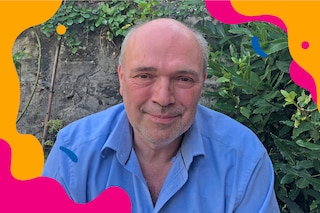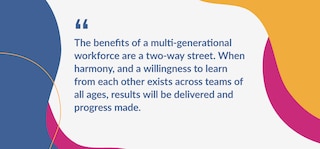Harnessing an environment where people of all ages can speak up
I’m 57. I’ve been at PMI for 23 years. But I’m always open to new learnings and ideas.
Getting opinions from people both young and old is hugely beneficial. Otherwise, some leftfield ideas would never be considered.
People who have been working closely on a project can be so focused on it, that they can become a little blinkered. Bringing other opinions to the table builds strength into our initiatives.
In the appropriate context, it’s like a stress test: if team members with varied levels of experience agree on a decision, there’s a good chance it will be the right one for most of our customers.
So, it’s important to make everyone feel part of the project, by encouraging them to speak up. If you can see your input in it, you’ll belong more to the project and the outcome is likely to be better.
How can younger generations in the workplace be particularly beneficial?
Take younger members of the company, for example. They have different experiences, points of view, and areas of expertise. They’re always telling me about functionalities I didn’t even know existed. That can make my job better and easier. In fact, they usually do.
That’s why it’s important junior employees aren’t inhibited. I may have 23 years’ experience at PMI, but someone else may have 23 years’ experience of life, with a different education, social, and economic background. They may contribute a perhaps untapped range of ideas. For me, that’s just as valuable to the process.
Bosses can set the scene for young recruits
A simple trick to make young members of your team feel involved and valued is to ask them by name if they have any input during meetings – without putting them in an awkward, uncomfortable position.
Senior management shouldn’t feel compelled to do all the heavy lifting and speak the most – it’s important to bring others into the conversation and hear what they have to say.
When you’re discussing a project or strategy, seek advice from your entire pool of talent – from the most junior to the most senior.
You can learn so much from others, regardless of their age, if you involve everyone in the project and unlock their creativity. That’s an important learning curve for management.
At PMI, leaders do listen – and that’s essential if we’re to fulfil our vision of a smoke-free future. Harnessing an environment in which everyone can speak up will give rise to opportunities to improve the business.
Breaking down barriers of multi-generational workforces
For established employees of a company, it can be tricky adapting to change. Some may even feel threatened by the younger generation, and the new skills and viewpoints they bring to the team.
However, veterans have got to be more accepting of transition and change. That has to happen – both in a business context and in life.
Just because I’ve spent two decades at PMI doesn’t mean I’ve been doing everything the right way. It doesn’t mean there isn’t more I can learn to streamline and modernize projects and processes.
For example, as I’ve made some colleagues in procurement aware, most people have been tying their shoelaces the wrong way their whole lives – but there’s actually a far more efficient, and less known technique. After watching it being demonstrated on YouTube, I’ve been tying my laces that way ever since. It took a bit of practice and perseverance, but I got there.
So, if you’re open to transition and change, you can teach an old dog new tricks. They rarely learn it from other dogs. They learn from the young pups.
Embracing new knowledge
Young people have taught me an awful lot about the technologies available to facilitate my work.
When I first arrived in Switzerland, I was working as a chef. I didn’t even know how to switch on a computer, so I went on a course to learn the basics. In other words, I wasn’t raised in the digitally-savvy world we live in today – and I’m still learning so much at PMI.
Younger people are far more inquisitive and have an appetite to learn new things. Change is the one constant in their lives – and that level of agility must be embraced by all of us.
For instance, we now have a team member doing analytical work on technical procurement. The reports she’s producing are absolutely amazing. I’ve never seen anything like it and didn’t know it could be done. I’m learning a lot from her.
It’s important to be open to new methods and not close down as you advance in age.
Combined learnings to deliver change
For all the attributes younger professionals bring to a company, the experiences and insights of older employees are also pivotal to success.
Despite my tenure at PMI, I still turn to people of a similar age and experience to me for their advice and input.
The benefits of a multi-generational workforce are a two-way street. When harmony, and a willingness to learn from each other exists across teams of all ages, results will be delivered and progress made.
There’s a vast wealth of knowledge and networks for younger workers to tap into, while senior managers should leverage innovations and new approaches from younger employees to fast-track objectives.
It’s important to remember that while ages may vary across organizations, relentless enthusiasm and a determination to drive change keeps every one of us young – in mind, if not in body.
Philip Morris International is changing. To help us shape our future, we need the best talent to join us. Click here to see what job opportunities are available in your region.
(Top image posed by models. © Getty Images)













